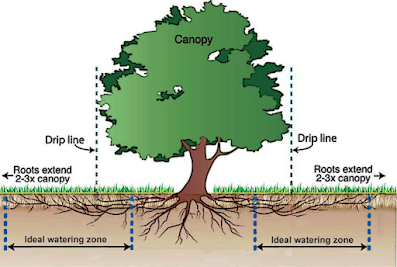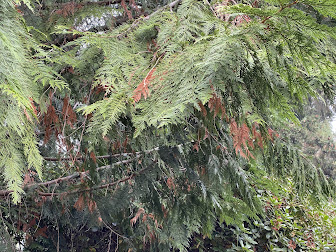Caring for our Environment, Urban Forests and Trees
Friday, October 28, 2022
Whether it’s your own backyard, neighborhood or neighboring park, the first step is to become aware of the environment around you.
Why should we care? Because we are a part of this ecosystem, we all call home. Imagine if we had not enough trees to provide shade or filter the stormwater which runs through our watersheds and into the Salish Sea which in turn provides nutrients to our local sea life - or imagine the loss of birds which keeps the insect population in check or provide bird songs? Even when weather is changing, make time to visit nearby woods alone and spend time in quiet observation.
 |
| Illustration courtesy https://www.traversotree.com/mature-during-drought/ |
Do you live near a bog or water – do you observe otters, beavers, snakes, frogs, salamanders or fish? Do you see or hear owls? Bats?
All of these animals and amphibians need the ecosystem to survive and our trees play a major role in their survival. And frankly, so do we.
If you are lucky to have tall trees on your property you can help with habitat diversity in your yard.
Suggestions include having a good ground layer including some downed wood for hiding and nests; a shrub layer for the birds to hide; and a strong overstory with mixed species of trees including broadleaf trees as they provide the most food and nesting value for birds and squirrels.
Also, try not to rake up all of your leaves as that provides nutrients for the soil and hiding places for our wildlife.
 |
| Flagging on cedar trees photo by Melody Fosmore |
However, the heat waves of the past couple of years have affected the health of our tall trees and you can help by watering these trees during the warmer and dry spells.
Once a week, about an inch of water to the soil, under the entire canopy diameter, is adequate. No need to overwater – and don’t let water sprinklers hit the bark of trees, they can physically damage the bark, causing fungus disease, and algae, inviting insect trouble.
Are you seeing signs of tree stress? Trees gain their growth from the crown, and so it’s at the top of the tree where you might see distress. No new growth, or the tip dying back is a warning sign. The heat dome of 2021 is really showing up now in our tree canopy. Even with the rain now here, continue to water just to re-saturate the water table. Monitor your tall trees for hazard branches that may require removal and always consult an arborist before you take a tree down. There may be hope!
Are you seeing signs of tree stress? Trees gain their growth from the crown, and so it’s at the top of the tree where you might see distress. No new growth, or the tip dying back is a warning sign. The heat dome of 2021 is really showing up now in our tree canopy. Even with the rain now here, continue to water just to re-saturate the water table. Monitor your tall trees for hazard branches that may require removal and always consult an arborist before you take a tree down. There may be hope!
 |
| Wildlife snag photo by Melody Fosmore |
The snags may not look ‘pretty’ but they provide an essential service to our local wildlife. I personally have enjoyed many moments of observing all the animals and birds enjoying a snag in my yard. The pileated woodpeckers are especially wonderful to observe.
Nesting boxes: Birds love nesting boxes in safe locations high enough off the ground from predators (including house cats). The boxes will need to be cleaned every year. See the attached resource in the list below for safe ways to hang a birdhouse.
Nesting boxes: Birds love nesting boxes in safe locations high enough off the ground from predators (including house cats). The boxes will need to be cleaned every year. See the attached resource in the list below for safe ways to hang a birdhouse.
 |
| Root damage photo by Melody Fosmore |
However, please bear in mind their impact - dogs running through salmonid bearing streams don't just spread disease to the water, they also tear up the reeds where the fish lay their eggs.
And, they can expose tree roots which then become non-functional and compromise the health of the tree.
Best to control their footprint and keep our woods healthy.
Keeping on the trail and not creating new trails also protects nesting, trees and the entire ecosystem. Leaving no trace and a light footprint protects our parks for all to enjoy.
Enjoy the bounty of our environment and remember - everything works together and mankind benefits from the ecosystem, not the other way around!
Resources:
Enjoy the bounty of our environment and remember - everything works together and mankind benefits from the ecosystem, not the other way around!
Resources:
- www.inaturalist.org/pages/seek_app: Download this app on your phone to capture photos and ID wildlife, plants, fungi.
- www.inaturalist.org/pages/seek_app
- https://www.oregonmetro.gov/sites/default/files/2017/09/28/impacts-of-dogs-on-wildlife-water-quality-science-review.pdf
- https://www.treehugger.com/best-bat-boxes-5190053
- https://www.treehugger.com/how-hang-birdhouse-without-harming-tree-4864009





2 comments:
Great article! Lots of good info and resources.
Christine Southwick
This is such a fantastic and informative article, thank you! Our trees are such a wonderful asset to our area and we must do what we can to save them and keep them happy and healthy!
Post a Comment